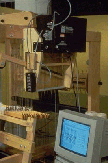September 03, 2004
oldies but goodies
Three from 1995
Thanks to Katherine Moriwaki for personaldebris… for all of life’s detritus and the documentation that leads back to the wonderful 1995 exhibition at Galerie La Centrale, Montréal, Québec. Canadian artists, by the way, have played a major role in networked art from very early on. I’ll be mentioning a number of them in my hopefully upcoming and definitely idiosyncratic history.
The Galerie La Centrale, Montréal show included works by Barbara Layne and Ingrid Bachmann, David Rokeby, and Paul Sermon.

Fault Lines (1995) by Barbara Layne and Ingrid Bachmann, was described in Katherine’s blog. It was a work in which computer-assisted looms were programmed to translate recorded daily seismographic information between two locales: Montreal and Santa Monica, CA. Increments of cloth were then woven each day by individual handweavers at each of the sites. The tectonic movements of the earth were thus recorded through one of the earliest and one of the most recent technologies.
Very Nervous System (1986-1990) by David Rokeby was a non-visual interactive sound installation that made use of video cameras, image processors, computers, synthesizers and a sound system to create a space in which the movements of one’s body created sound/music. Upon entering a room, the viewer became aware that his/her simple displacement of air caused a reaction of sound within the environment., altering the otherwise seemingly empty site. As Wired said of this work: "David Rokeby's Very Nervous System does a number of things. But mostly it does this: it watches you. This piece of art tracks the slightest movement of the human body. Rokeby wires up a space the size of a dance floor, and whatever moves through it is sucked into the artwork. Very Nervous System makes something out of you. It turns you into a symphony. Or a jazz song. Or a samba."

And Paul Sermon's Telematic Dreaming (1992) - we described in an earlier blog. But here it is again. A bed was set up within the gallery space onto which an image of a person in another bed was projected in real-time. The viewer was then able to interact with this telepresence producing what one reviewer called “an uncanny exchange.”
The basic technical system consisted of a camera situated above a queen-size bed. The camera received an overhead view of the bed. The image of the bed and someone lying on it, was sent via ISDN lines and teleconferencing systems to a video projector situated above another bed in a geographically distant location. The live image was projected down on to the bed, and with it the live, life-size image of the person. Another video camera situated next to the video projector sent an image of the projection and the second person lying on the bed under the projection, back to the first bed.
You can google all three works for more information. What strikes me at the moment is that while they are all “installations” and exhibited in a gallery, they are also “performances” and either involve performers (handweavers in Fault Lines) or audience members who do something (perform) to create the work. And that all three deal with the physical or material and the virtual, challenging the notion, prevalent at the time (remember William Gibson?), that these two realms were separate.
Posted by newradio at September 3, 2004 10:17 AM
